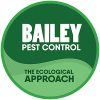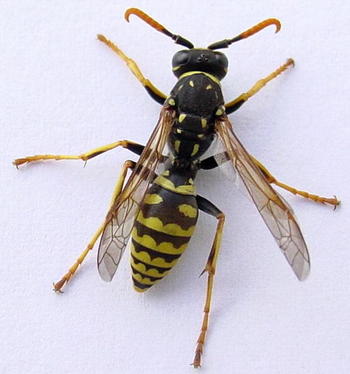Wasp problems in Brighton, and other parts of Sussex will only get more severe as the summer approaches. So before you’re faced with pest problem that’s yellow and black and comes with a sting, here’s a bit for more information to help you understand why you might get a wasp problem.
The common wasp, Vespula vulgaris, is a yellowjacket wasp found in much of the Northern Hemisphere — which unfortunately for you, includes Sussex! It is a eusocial vespid, which builds its grey paper nest underground, often using an abandoned hole as a place to start building the site. The wasp nest is then enlarged by the worker wasps. The queen wasp may also select a hollow tree, wall cavity, or rock crevice for a nest site.
The common wasp normally measures about 12 mm to 17 mm from head to abdomen. The queen wasp is normally about 20 mm long. It has distinctive warning colours of black and yellow. Additionally it can be distinguished by a lack of black dots on its back (gastral terga), which are located further up and form part of the black rings on each of the abdomen’s six segments. Furthermore the part of the head to which the jaws are attached is usually broken by black.
The wasp nest is made from chewed wood fibres, mixed with saliva. It has open cells and a petiole attaching the nest to the substrate. The wasps produce a chemical which repels ants and secrete it around the base of this petiole in order to avoid ant predation. A solitary female queen wasp starts the nest, building 20–30 cells before initial egg-laying. This phase begins in spring, depending on climatic conditions. She fashions a petiole and produces a single cell at the end of it. Six further cells are then added around this to produce the characteristic hexagonal shape of the nest cells. The spherical nest is built up from layers of cells.
Once the wasp larvae have hatched as workers, they take up most of the colony’s foraging, brood care and nest maintenance. A finished nest may contain 5,000–10,000 wasps.
Each wasp colony includes one queen and a number of sterile workers. Colonies usually last only one year, all but the queen dying at the onset of winter.
So if you don’t want the problem of 10,000 wasps in your home this summer, check out our wasp removal service. With a free site survey and an environmentally friendly way of removing your wasp problem, you’ve got an affordable way to have a wasp free summer.
The common wasp, Vespula vulgaris is a yellow jacket wasp found in much of the Northern Hemisphere, and introduced to Australia and New Zealand. It is a eusocial vespid, which builds its grey paper nest underground, often using an abandoned mammal hole as a start for the site, which is then enlarged by the workers. The foundress queen may also select a hollow tree, wall cavity, or rock crevice for a nest site.

